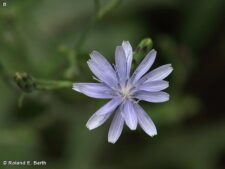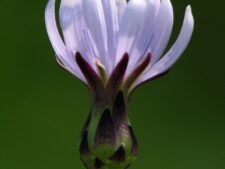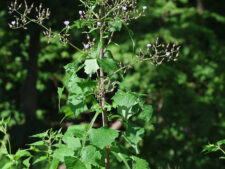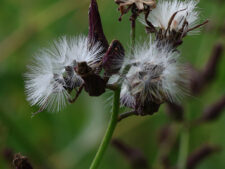
WOODLAND LETTUCE
Lactuca floridana
SUNFLOWER FAMILY (Asteraceae)
 Identification
Identification
- Flowering time - August, September
- Uncommon in woodlands at FF & NW
- Small, blue dandelion-like flowers
- Open, many branched flower cluster
- See comments for comparison with similar species
This native annual or biennial grows up to 10 feet tall with numerous, often as many as 100, flower heads (D). The lower leaves, up to 10 inches long, are deeply cut with triangular apexes (E). Upper leaves are smaller and may be either lobed or unlobed. Both stem and leaves contain a milky white sap. The small flowers, about 1/2 inch across, have up to 15 blue (sometimes white) ray florets (A,B). Flowers emerge from a cone-shaped to cylindrical structure of overlapping bracts (phyllaries) with purplish tips that persist at the base of the flower after it opens (C). The seeds have “parachutes” of white, shiny hairs (F).
Found in woodlands and edges, flowering in August and September. Uncommon in upland and lowland woodlands and openings at Fontenelle Forest and Neale Woods.
Woodland Lettuce and the less common Blue Lettuce (Mulgedium pulchellum) both have similar blue dandelion-like flowers and white milky sap. Woodland Lettuce has a larger, more branched, open flower cluster but much smaller flowers . Look also for its more deeply lobed lower leaves, often with a large triangular lobe at the tip. Another look-alike, Wild Lettuce (Lactuca canadensis), is found in similar places, but has yellow or yellow-orange flowers and light brown sap.
Woodland Lettuce, also known as Florida and False Lettuce, is a close relative of our garden lettuce.
The content of NatureSearch is provided by dedicated volunteer Naturalists of Fontenelle Forest who strive to provide the most accurate information available. Contributors of the images retain their copyrights. The point of contact for this page is: Roland Barth.





